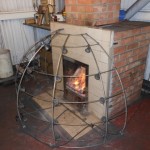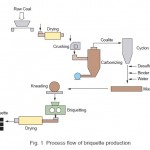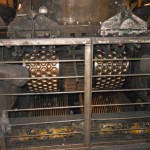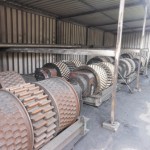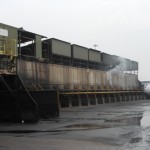30/5/14
SOLID FUEL MANUFACTURE
Recently I have been fortunate enough to visit the Coal Products Limited (CPL) Briquetting works at Immingham, South Humberside. The visit was proposed by the Guild of Master Chimney Sweeps and welcomed by CPL. It was open to all members of the Guild and we had members from as far away as Cornwall attending. The site is in the docks area and only 200 metres away from the dockside. We arrived with only a few stragglers and started off with a presentation about the works, its history, the process and the products produced. This was followed by a tour of the site.
The site itself is split into two parts and old production site and a new one. Production runs 365 days a year. Although dirty, as one would expect, it is well organised and clutter free. All areas are kept watered down to control any dust/air pollution. As much
water as possible is recycled back into the production process. The hub of the production facility is the control room. Here the whole process is monitored both visually and electronically. Should there be a mechanical or system fault then there is build in redundancy to ensure that production continues. An onsite maintenance team is always available. Each batch is analysed in the onsite laboratory to ensure that it will meet the product description, consistency and performance parameters. The processing is surprisingly much like baking a cake. It comprises mixing, crushing, drying, adding some liquid binding agent shaping and then baking. The raw products are mixed together at various stages and the temperature is adjusted as required. As with most things in life briquette production is a compromise to get the finished product. The skill lies with mixing the exact quantities of the various ingredients to achieve a consistent, specific product with the desired characteristics.
The basic ingredients are:
Anthracite – naturally smokeless coal but difficult to ignite.
Bituminous coal – has a high bitumen content and is 60 – 80% carbon.
Petroleum coke – sediment left over from crude oil cracking.
Binding agent – currently molasses.
These will vary depending on the required product characteristics such as burn time, sulphur content, ease of ignition and so on. In addition the quality and chemical composition of the base product has to be allowed for and the mix adjusted as required.
The diagram below shows this process:
The raw coal and anthracite are mixed, dried and crushed.They are then mixed with the pet coke and finally the binding agent.
Once the mix is completed the batch resembles a powdery black cake mix. This mix is the run between pairs of large rollers or“tyres” which give a distinct shape and or marking. As you can see the tyres are big and very heavy. They have to be inserted into the heart of the pant and aligned perfectly to form the desired shape. They take hours to change so a specific fuel product run can last for days. Some briquettes are formed into ovals such as Homefire and Wildfire and these will be further subdivided by a number of lines running around the oval. Others such as Ecoal 50 are hexagonal.
Once shaped the briquettes are run through a series of ovens which increase in temperature and bake to briquettes into the hard,dense form that we are used to. Once baked the product is cooled, to ensure it does not spontaneously combust, loaded onto lorries and dispatched for bagging.
Remember do not use house coal in a stove, only stove coal. If you need more information about the types of stove coal or other fuel available available then visit the CPL website.
